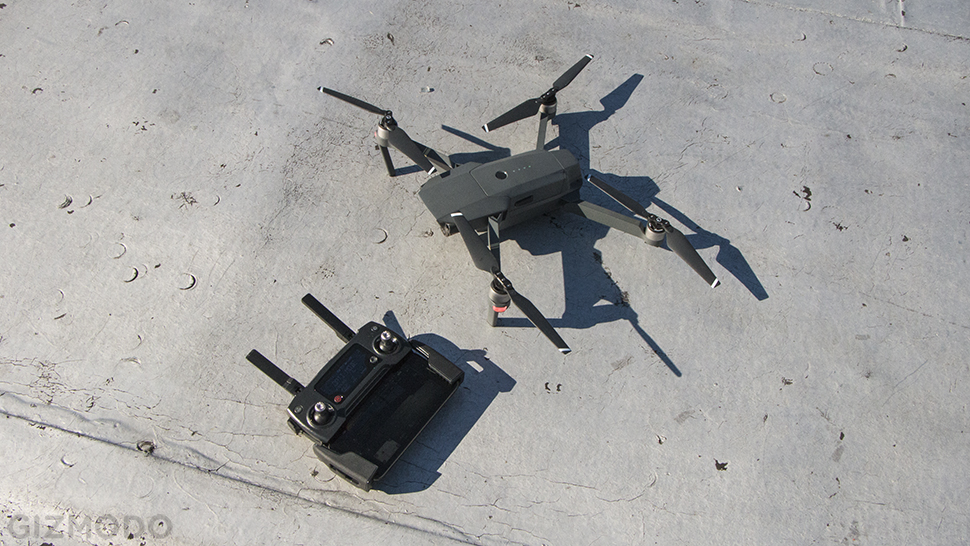When the Mavic Pro arrived in our offices, the reaction was unanimous: holy shit, it’s small. The folding drone is roughly the size and weight of a hefty Italian sandwich. This compact form factor, I’d come to learn, is a blessing and a curse for the Mavic Pro — emphasis on the blessing.
Images: Adam Clark Estes / Gizmodo
Let’s get one thing straight: this drone is a thrill to fly. Once I felt comfortable with the controls, I giggled when I flew it down a tight tree-lined street, even between the branches, without crashing. In fact, after a month of testing, I haven’t crashed the Mavic Pro once. (This is basically never the case when I test drones.)
What’s more thrilling is the fact that we’re entering an exciting new era of super smart, super small quadcopters. Tiny drones with high definition cameras and advanced autonomous features are the future we were promised. But the balance is difficult to strike. Lower-priced efforts like the $999 Parrot Bebop 2 feel like toys, while the $1699 DJI Phantom 4 could be seen as too big or a beginner drone pilot who craves portability. Also priced at $1699, the DJI Mavic Pro fits in your jacket pocket and do just as many neat tricks as its storied older sibling.
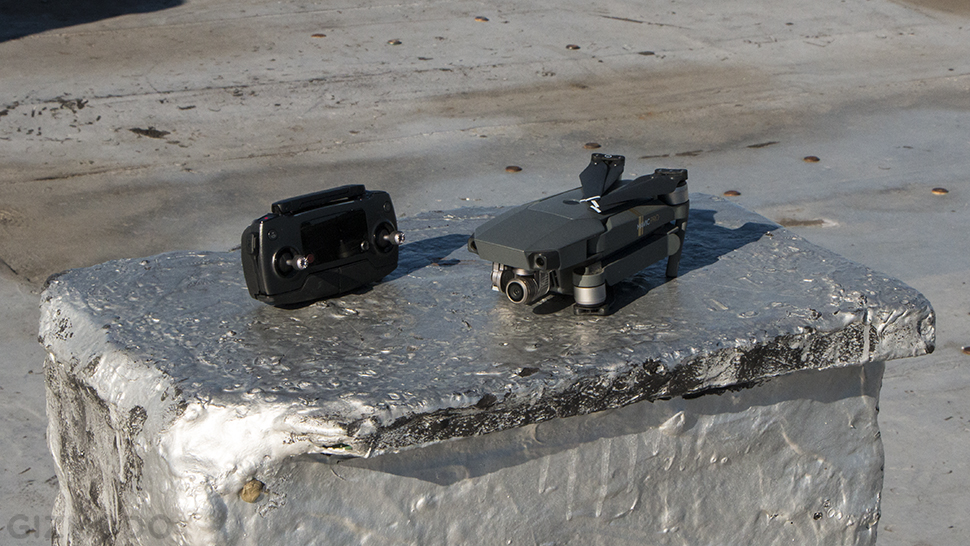
The whole package is almost smaller than your lunch.
The Mavic Pro and the Phantom 4 are actually pretty comparable in terms of specs. Both feature good 4K cameras. (The Phantom 4 is slightly more robust with HDR still photography capabilities and a slightly wider-angle lens.) Both come with obstacle avoidance technology as well as visual tracking that will follow a subject with the tap of a smartphone screen. Both can exceed speeds of 64km-per-hour and fly almost completely autonomously with tap-to-fly and waypoint functionality.
But the Mavic Pro is so delightfully small. Having tested over a dozen drones in New York City, I’ve always struggled with the fact that these gadgets don’t travel well. Even throwing a Phantom in the trunk of a car feels like you’re a speed bump away from breaking some of the sophisticated guts. Forget carrying a Phantom to a picnic in the park without feeling like a goon. The Mavic Pro, however, in its hoagie-sized brilliance, changes the game.

The Mavic Pro is almost smaller than the Phantom 4’s seemingly compact controller, and the folding process is delightfully easy. (Gif: Mandy Mandelstein)
The folding part works kind of like a Transformer. The forward rotor arms wing out horizontally when it’s time to fly, and the aft rotors swing down and back. Meanwhile, the new controller unfolds from the bottom in a gull wing sort of motion to create a cosy space for your mobile device. The process requires a lot of moving parts, but by the time you’re ready to take off, the overall design feels nothing short of elegant.

The Mavic Pro’s controller is roughly the size of an iPhone, albeit much thicker. That’s delightfully compact, even though the joysticks are also tiny and sometimes hard to use. (Gif: Mandy Mandelstein)
But once the Mavic Pro is in the air things get a little bit dicey. As any experienced pilot will tell you, slimming down the size of a drone sacrifices stability and payload capabilities. The diagonal size of the unfolded Mavic Pro is just 15 millimetres smaller than the Phantom 4, and the smaller aircraft, at 1kg, is over a pound lighter than its bigger sibling. This matters when the drone is getting hit by a gust of wind while in the air or trying and failing to match the boy-wow acceleration of the beefier Phantom 4.
All that said, DJI’s fancy Intelligent Flight Modes are incredibly impressive, especially when it comes to avoiding jerky footage. Using the Waypoint and TapFly features serves up buttery smooth movements without touching the sticks at all. The Mavic Pro also includes ActiveTrack wherein the camera recognises a subject (like you) and keeps that subject in the center of the frame as it moves. ActiveTrack works ok, but it’s not hard to move too quickly for the drone to follow.
The Follow Me mode is less enchanting. It should be the holy grail of aerial photography for activities like mountain biking and snowboarding, but it’s a tough task to accomplish. The Mavic Pro can recognise the radio signal from the controller and follow that signal wherever it goes.
Unfortunately for me, I never got Follow Me to work, due to issues with satellite connectivity. There’s a solid chance that this is a New York City radio interference problem, but I can’t say so for sure. (I reached out to DJI to find out more about the satellite issue; the company did not respond.) In any case, the Mavic Pro does feature some very useful obstacle avoidance sensors on the front that work up to speeds of 35km per hour.
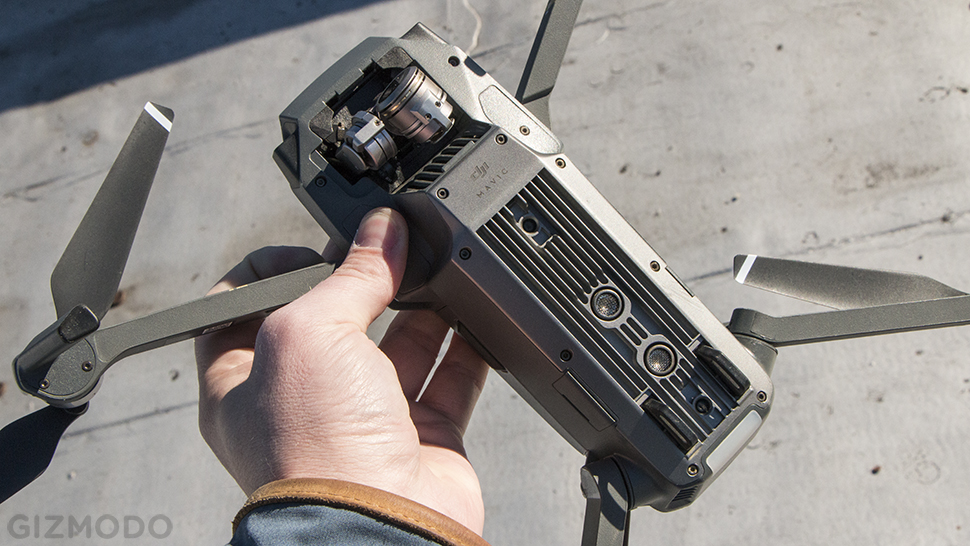
The bottom of the Mavic Pro features one optical camera and two ultrasonic sensors to watch the ground.
The Mavic Pro’s gimbal is also terribly finicky. For drone newbies, the gimbal is the very important, robotic mount that holds the camera. The gimbal is what lets you pan the camera up and down, and it also stabilizes the camera when the drone is in the air. If the gimbal gets out of whack, you’re going to end up with shaky or crooked images. Crooked is the problem with the Mavic Pro, and you can see it in our test footage.
The folding drone’s camera and gimbal are about a third the size of the setup of the Phantom 4, and they also feel≥ more fragile. After my first few flights, I noticed that my footage would become increasingly crooked the longer I stayed airborne. This was obvious since I like taking shots of the New York City skyline at sunset, but the footage looks silly when the horizon is tilted at a 5-degree angle. Thankfully, there’s an easy fix in adjusting the gimbal roll (i.e. the horizontal position of the camera), but the added frustration of calibrating the drone mid-flight sucks.
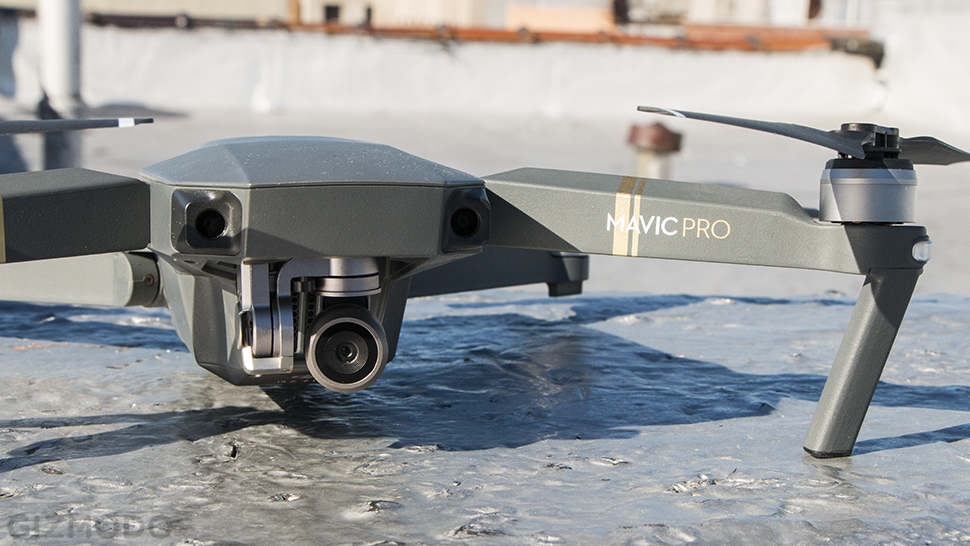
That tiny gimbal comes with consequences.
When it comes to considering the Mavic Pro as an aerial photography drone, the apples-to-apples comparison to the Phantom 4 make less sense. Larger drones mean bigger payloads that can carry beefier cameras. And sturdier drones offer more stable flights and often smoother footage. The Mavic Pro is not a large or sturdy drone, and you can tell when you’re shooting video. If you want to capture beautiful footage from above, you should be considering a wider range of devices, including not only the Phantom series but also Yuneec’s Typhoon range (namely the Typhoon H).
Those will give you better camera control. The short RC controller sticks on the Mavic Pro’s controller makes subtle movements and rotating shots tough. Meanwhile, the forward-facing camera means that rotating the drone is the only way to get panoramic shots. This isn’t a deal breaker, but the Mavic Pro is definitely geared more towards the mobile, adventuring crew than the cinematographer hopefuls.
The Mavic Pro also struggles with low light video, compared to other drones I’ve tested, including the Phantom 4 and the Typhoon H. There are ISO and exposure settings adjustments that could improve the footage, especially for still photography. But tweaking settings, isn’t very helpful if you’re shooting on the fly and need to get the perfect shot right away.
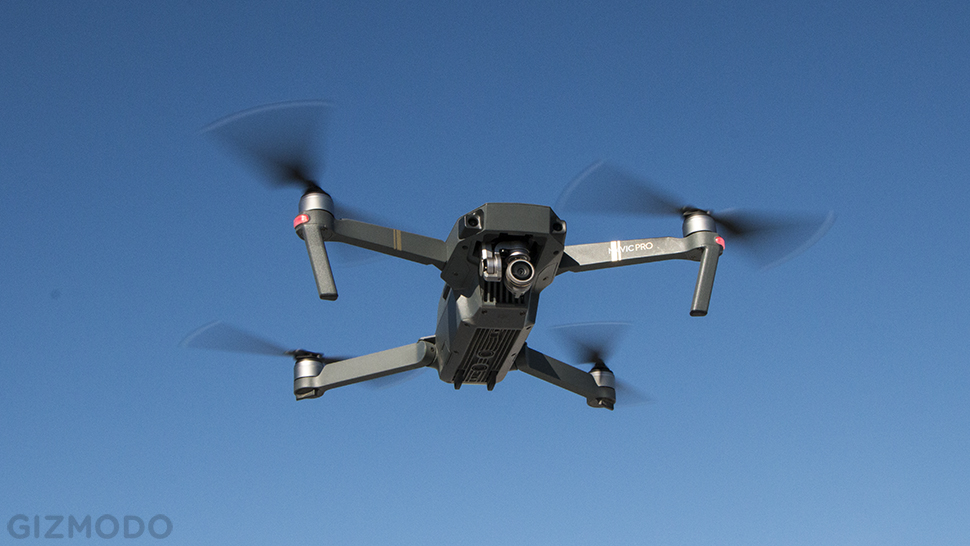
It flies.
The Mavic Pro experience is littered with little tradeoffs like these. There’s also the fact that DJI has delayed shipping on countless orders, so you might not even receive your Mavic Pro for a few weeks. (I reached out to DJI to ask about on-going delays; the company didn’t respond.)
Personally, I’d trade portability for some gimbal quirks and camera shortcomings any day of the week. But I’m a daytime flier who doesn’t own a car and enjoys taking my drones on trips. Other drone-curious consumers should also be attracted to the price: $US200 ($267) less than the Phantom. Until I find something better, the Mavic Pro is what I’d buy if I had decently deep pockets and seriously wanted to get into the quadcopter game. You probably want it, too.
Video: Melissa Murray
README
- Delightfully foldable and portable without sacrificing features
- Camera gets crooked on longer flights, but it’s easy enough to correct
- Autopilot features offer lots of effortless flight possibilities
- Lightweight construction can struggle in the wind
- $US1,000 ($1,336) is a lot of money
- But it’s so tiny!
